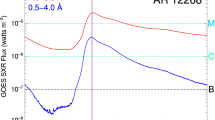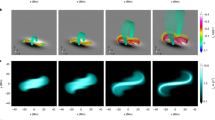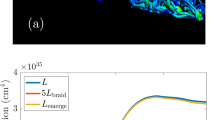Abstract
Solar coronal mass ejections are the most energetic events in the Solar System. In their standard formation model, a magnetic flux rope builds up into a coronal mass ejection through magnetic reconnection that continually converts overlying, untwisted magnetic flux into twisted flux enveloping the pre-existing rope. However, only a minority of coronal mass ejections carry a coherent magnetic flux rope as their core structure, which casts doubt on the universality of this orderly wrapping process. Here we provide observational evidence of a different formation and eruption mechanism of a magnetic flux rope from an S-shaped thread, where its magnetic flux is fully replaced via flare reconnections. One of the footpoints of the sigmoidal feature slipped and expanded during the formation, and then moved to a completely new place, associated with the highly dynamical evolution of flare ribbons and a twofold increase in magnetic flux through the footpoint, during the eruption. Such a configuration is not predicted by standard formation models or numerical simulations and highlights the three-dimensional nature of magnetic reconnections between the flux rope and the surrounding magnetic field.
This is a preview of subscription content, access via your institution
Access options
Access Nature and 54 other Nature Portfolio journals
Get Nature+, our best-value online-access subscription
$32.99 / 30 days
cancel any time
Subscribe to this journal
Receive 12 digital issues and online access to articles
$119.00 per year
only $9.92 per issue
Buy this article
- Purchase on SpringerLink
- Instant access to full article PDF
Prices may be subject to local taxes which are calculated during checkout






Similar content being viewed by others
Data availability
The data used in the study are publicly available for download from the corresponding mission archives. SDO data are available at http://jsoc.stanford.edu/ajax/lookdata.html; IRIS data are available at https://iris.lmsal.com/data.html.
References
Patsourakos, S. et al. Decoding the pre-eruptive magnetic field configurations of coronal mass ejections. Space Sci. Rev. 216, 131 (2020).
Liu, R. Magnetic flux ropes in the solar corona: structure and evolution toward eruption. Res. Astron. Astrophys. 20, 165 (2020).
Priest, E. R. & Forbes, T. G. The magnetic nature of solar flares. Astron. Astrophys. Rev. 10, 313–377 (2002).
Temmer, M. Space weather: the solar perspective. Living Rev. Sol. Phys. 18, 4 (2021).
Cheng, X., Guo, Y. & Ding, M. Origin and structures of solar eruptions I: magnetic flux rope. Sci. China Earth Sci. 60, 1383–1407 (2017).
Schmieder, B., Aulanier, G. & Vršnak, B. Flare-CME models: an observational perspective. Sol. Phys. 290, 3457–3486 (2015).
Green, L. M., Török, T., Vršnak, B., Manchester, W. & Veronig, A. The origin, early evolution and predictability of solar eruptions. Space Sci. Rev. 214, 46 (2018).
Zhang, J., Cheng, X. & Ding, M.-D. Observation of an evolving magnetic flux rope before and during a solar eruption. Nat. Commun. 3, 747 (2012).
Patsourakos, S., Vourlidas, A. & Stenborg, G. Direct evidence for a fast coronal mass ejection driven by the prior formation and subsequent destabilization of a magnetic flux rope. Astrophys. J. 764, 125 (2013).
Moore, R. L., Sterling, A. C., Hudson, H. S. & Lemen, J. R. Onset of the magnetic explosion in solar flares and coronal mass ejections. Astrophys. J. 552, 833–848 (2001).
Karpen, J. T., Antiochos, S. K. & DeVore, C. R. The mechanisms for the onset and explosive eruption of coronal mass ejections and eruptive flares. Astrophys. J. 760, 81 (2012).
Gou, T., Liu, R., Kliem, B., Wang, Y. & Veronig, A. M. The birth of a coronal mass ejection. Sci. Adv. 5, eaau7004 (2019).
Kopp, R. A. & Pneuman, G. W. Magnetic reconnection in the corona and the loop prominence phenomenon. Sol. Phys. 50, 85–98 (1976).
Lin, J. & Forbes, T. G. Effects of reconnection on the coronal mass ejection process. J. Geophys. Res. 105, 2375–2392 (2000).
Démoulin, P. Extending the concept of separatrices to QSLs for magnetic reconnection. Adv. Space Res. 37, 1269–1282 (2006).
Aulanier, G., Janvier, M. & Schmieder, B. The standard flare model in three dimensions. I. Strong-to-weak shear transition in post-flare loops. Astron. Astrophys. 543, A110 (2012).
Aulanier, G. et al. The standard flare model in three dimensions. II. Upper limit on solar flare energy. Astron. Astrophys. 549, A66 (2013).
Janvier, M., Aulanier, G., Pariat, E. & Démoulin, P. The standard flare model in three dimensions. III. Slip-running reconnection properties. Astron. Astrophys. 555, A77 (2013).
Titov, V. S., Hornig, G. & Démoulin, P. Theory of magnetic connectivity in the solar corona. J. Geophys. Res. Space Phys. 107, 1164 (2002).
Janvier, M. et al. Electric currents in flare ribbons: observations and three-dimensional Standard Model. Astrophys. J. 788, 60 (2014).
Wang, W. et al. Buildup of a highly twisted magnetic flux rope during a solar eruption. Nat. Commun. 8, 1330 (2017).
Veronig, A. M., Gömöry, P., Dissauer, K., Temmer, M. & Vanninathan, K. Spectroscopy and differential emission measure diagnostics of a coronal dimming associated with a fast halo CME. Astrophys. J. 879, 85 (2019).
Xing, C., Cheng, X. & Ding, M. D. Evolution of the toroidal flux of CME flux ropes during eruption. Innovation 1, 100059 (2020).
Burlaga, L., Sittler, E., Mariani, F. & Schwenn, R. Magnetic loop behind an interplanetary shock: Voyager, Helios, and IMP 8 observations. J. Geophys. Res. 86, 6673–6684 (1981).
Klein, L. W. & Burlaga, L. F. Interplanetary magnetic clouds at 1 AU. J. Geophys. Res. 87, 613–624 (1982).
Chi, Y. et al. Statistical study of the interplanetary coronal mass ejections from 1995 to 2015. Sol. Phys. 291, 2419–2439 (2016).
Vourlidas, A., Lynch, B. J., Howard, R. A. & Li, Y. How many CMEs have flux ropes? Deciphering the signatures of shocks, flux ropes, and prominences in coronagraph observations of CMEs. Sol. Phys. 284, 179–201 (2013).
Song, H. Q. et al. Do all interplanetary coronal mass ejections have a magnetic flux rope structure near 1 au? Astrophys. J. Lett. 901, L21 (2020).
Cheng, X., Ding, M. D. & Fang, C. Imaging and spectroscopic diagnostics on the formation of two magnetic flux ropes revealed by SDO/AIA and IRIS. Astrophys. J. 804, 82 (2015).
Dudík, J. et al. Slipping magnetic reconnection, chromospheric evaporation, implosion, and precursors in the 2014 September 10 X1.6-class solar flare. Astrophys. J. 823, 41 (2016).
Zhao, J. et al. Hooked flare ribbons and flux-rope-related QSL footprints. Astrophys. J. 823, 62 (2016).
Démoulin, P., Priest, E. R. & Lonie, D. P. Three-dimensional magnetic reconnection without null points 2. Application to twisted flux tubes. J. Geophys. Res. 101, 7631–7646 (1996).
Li, T. & Zhang, J. Quasi-periodic slipping magnetic reconnection during an X-class solar flare observed by the Solar Dynamics Observatory and Interface Region Imaging Spectrograph. Astrophys. J. Lett. 804, L8 (2015).
Aulanier, G. & Dudík, J. Drifting of the line-tied footpoints of CME flux-ropes. Astron. Astrophys. 621, A72 (2019).
Dudík, J., Lörinčík, J., Aulanier, G., Zemanová, A. & Schmieder, B. Observation of all pre- and post-reconnection structures involved in three-dimensional reconnection geometries in solar eruptions. Astrophys. J. 887, 71 (2019).
van Driel-Gesztelyi, L. et al. Coronal magnetic reconnection driven by CME expansion—the 2011 June 7 event. Astrophys. J. 788, 85 (2014).
Török, T. et al. Sun-to-Earth MHD simulation of the 2000 July 14 ‘Bastille Day’ eruption. Astrophys. J. 856, 75 (2018).
Qiu, J., Hu, Q., Howard, T. A. & Yurchyshyn, V. B. On the magnetic flux budget in low-corona magnetic reconnection and interplanetary coronal mass ejections. Astrophys. J. 659, 758–772 (2007).
Wang, Y., Zhou, Z., Shen, C., Liu, R. & Wang, S. Investigating plasma motion of magnetic clouds at 1 AU through a velocity-modified cylindrical force-free flux rope model. J. Geophys. Res. Space Phys. 120, 1543–1565 (2015).
Kazachenko, M. D., Lynch, B. J., Welsch, B. T. & Sun, X. A database of flare ribbon properties from the Solar Dynamics Observatory. I. Reconnection flux. Astrophys. J. 845, 49 (2017).
Tschernitz, J., Veronig, A. M., Thalmann, J. K., Hinterreiter, J. & Pötzi, W. Reconnection fluxes in eruptive and confined flares and implications for superflares on the Sun. Astrophys. J. 853, 41 (2018).
Jiang, C. et al. A fundamental mechanism of solar eruption initiation. Nat. Astron. 5, 1126–1138 (2021).
Lemen, J. R. et al. The Atmospheric Imaging Assembly (AIA) on the Solar Dynamics Observatory (SDO). Sol. Phys. 275, 17–40 (2012).
Pesnell, W. D., Thompson, B. J. & Chamberlin, P. C. The Solar Dynamics Observatory (SDO). Sol. Phys. 275, 3–15 (2012).
Schou, J. et al. Design and ground calibration of the Helioseismic and Magnetic Imager (HMI) instrument on the Solar Dynamics Observatory (SDO). Sol. Phys. 275, 229–259 (2012).
Titov, V. S., Priest, E. R. & Demoulin, P. Conditions for the appearance of ‘bald patches’ at the solar surface. Astron. Astrophys. 276, 564–570 (1993).
Titov, V. S. & Démoulin, P. Basic topology of twisted magnetic configurations in solar flares. Astron. Astrophys. 351, 707–720 (1999).
De Pontieu, B. et al. The Interface Region Imaging Spectrograph (IRIS). Sol. Phys. 289, 2733–2779 (2014).
Cheung, M. C. M. et al. Thermal diagnostics with the Atmospheric Imaging Assembly on board the Solar Dynamics Observatory: a validated method for differential emission measure inversions. Astrophys. J. 807, 143 (2015).
Su, Y. et al. Determination of differential emission measure from solar extreme ultraviolet images. Astrophys. J. Lett. 856, L17 (2018).
Gou, T., Liu, R. & Wang, Y. Do all candle-flame-shaped flares have the same temperature distribution? Sol. Phys. 290, 2211–2230 (2015).
Acknowledgements
We acknowledge SDO and IRIS teams for the science data. IRIS is a NASA Small Explorer Mission developed and operated by LMSAL with mission operations executed at NASA Ames Research Center and major contributions to downlink communications funded by ESA and the Norwegian Space Centre. T.G. thanks the BBSO staff for providing Hα data. T.G., R.L., W.W., M.X. and Y.M. acknowledge support from the National Natural Science Foundation of China (NSFC 42188101, 42274204, 11903032, 11925302, 12003032) and the Strategic Priority Program of the Chinese Academy of Sciences (XDB41030100). A.M.V. acknowledges the Austria Science Fund (FWF), project I-4555N. T.L. acknowledges support from NSFC 12222306. T.G. also acknowledges support from the CAS Key Laboratory of Solar Activity.
Author information
Authors and Affiliations
Contributions
T.G. and R.L. led the study and analysis, interpreted the data, and wrote the manuscript. A.M.V. discussed the analysis and contributed to the interpretation, conclusion, and writing of the manuscript. B.Z. led the in situ data analysis and discussed the interpretation. T.L. and Y.W. discussed the results and contributed to the interpretation. W.W. and M.X. contributed to the SDO and in situ data analyses. All authors participated in the discussion and contributed to finalizing the manuscript.
Corresponding authors
Ethics declarations
Competing interests
The authors declare no competing interests.
Peer review
Peer review information
Nature Astronomy thanks Hongqiang Song and the other, anonymous, reviewer(s) for their contribution to the peer review of this work.
Additional information
Publisher’s note Springer Nature remains neutral with regard to jurisdictional claims in published maps and institutional affiliations.
Extended data
Extended Data Fig. 1 Hα observation of the filament from the Big Bear Solar Observatory (BBSO).
Panels (a-c) show the Hα line center images before, during, and after the sigmoid eruption, respectively. The arrow in panel (a) denotes the filament aligned with the main PIL of the active region.
Extended Data Fig. 2 MFR buildup during the flare precursor phase.
From the top to bottom are SDO/AIA 131 Å base-difference images, ratio of SDO/AIA 1600 Å and 1700 Å images, SDO/AIA 131 Å images zooming in on the eastern foot of the sigmoid, and simultaneous IRIS SJI 1400 Å images (Methods). The white dotted rectangle in panel (b) indicates the FOV of panels (c & d). Three white lines in panels (a & d) indicate the virtual slits S1-S3 for the stack plots in Fig. 4(c–e) (Methods), whose starting points are labeled as ‘0’. The yellow arrow in the IRIS image indicates the extending direction of the ribbon. Yellow dotted lines in the AIA 131 Å image at 17:12 UT denote the location of the trapezoidal ribbon observed in IRIS 1400 Å at the same time (see also Fig. 5a & d).
Extended Data Fig. 3 DEM results in different evolutionary phases.
(a,b) EM maps in temperature ranges of 5-10 and 10-20 MK, respectively. (c) Maps of the DEM-weighted mean temperature (Methods). (d) DEM distributions sampled from two locations (4 × 4 pixels2), one on the sigmoid (‘S’) and the other from nearby as a reference (‘R’), in blue and black, respectively. Light blue and gray curves give 250 times of Monte Carlo simulations as an estimation of the DEM uncertainty (Methods). The mean temperature and total EM of the sigmoid sample ‘S’ are annotated.
Extended Data Fig. 4 SDO/AIA and IRIS observations during the MFR eruption phase.
From the top to bottom are SDO/AIA 131 Å, 1600 Å, 335 Å base ratio, and IRIS SJI 1400 Å images. The white dotted rectangle in panel (b) indicates the FOV of panels (c & d). The yellow dotted lines in IRIS 1400 Å are the same as those in Fig. 5 & Extended Data Fig. 2. The yellow arrow indicates the extending direction of the negative ribbon NRn. The white dotted line indicates the virtual slit S4 for the stack plot in Fig. 4f (Methods), with its starting point labeled by ‘0’.
Extended Data Fig. 5 Coronal dimmings during the MFR eruption.
Panels (a-c) show the SDO/AIA 335 Å, 304 Å, and 211 Å images, and panels (d-f) show corresponding base-ratio images.
Extended Data Fig. 6 SDO/AIA observations of the sigmoid eruption.
(a-c) AIA 131 Å and 211 Å running-difference images showing the pre-eruption MFR and the erupting CME. (d-f) AIA observations of coronal dimmings in 171 Å base-difference image, post-flare loops in 94 Å, and flare ribbons in 1600 Å, during the flare decay phase. Two boxes in panel (d) indicate the regions to obtain 171 Å dimming lightcurves in Fig. 4a (Methods).
Supplementary information
Supplementary Information
Supplementary Notes, Supplementary Fig. 1 and captions of Supplementary Videos 1–4.
Supplementary Video 1
SDO/AIA observation of the solar eruption near the disk centre. The composite RGB images are made from AIA 131 Å (green), 171 Å (orange) and 1,600 Å (blue) channels, which are sensitive to plasma temperatures of about 11, 0.7 and 0.1 MK, respectively.
Supplementary Video 2
SDO/AIA multiwavelength observation starting from several hours before the eruption.
Supplementary Video 3
SDO/AIA and IRIS observation of the flux-rope formation and eruption. IRIS’s FOV only covers the eastern part of the event, as indicated by the white dotted rectangle. Ratios of AIA 1,600 Å and 1,700 Å images are used to highlight the ribbon morphology during the precursor phase before 17:21 ut.
Supplementary Video 4
SDO/AIA 335 Å and its base-ratio images featuring coronal dimmings during the solar eruption.
Rights and permissions
Springer Nature or its licensor (e.g. a society or other partner) holds exclusive rights to this article under a publishing agreement with the author(s) or other rightsholder(s); author self-archiving of the accepted manuscript version of this article is solely governed by the terms of such publishing agreement and applicable law.
About this article
Cite this article
Gou, T., Liu, R., Veronig, A.M. et al. Complete replacement of magnetic flux in a flux rope during a coronal mass ejection. Nat Astron 7, 815–824 (2023). https://doi.org/10.1038/s41550-023-01966-2
Received:
Accepted:
Published:
Issue date:
DOI: https://doi.org/10.1038/s41550-023-01966-2
This article is cited by
-
Quasi-Separatrix Layers and Three-Dimensional Magnetic Reconnection: Theory and Observations of Solar Flares (Invited Review)
Solar Physics (2025)
-
Coronal dimmings and what they tell us about solar and stellar coronal mass ejections
Living Reviews in Solar Physics (2025)
-
Circular-ribbon flares and the related activities
Reviews of Modern Plasma Physics (2024)
-
Properties of Type-II Radio Bursts in Relation to Magnetic Complexity of the Solar Active Regions
Solar Physics (2024)



